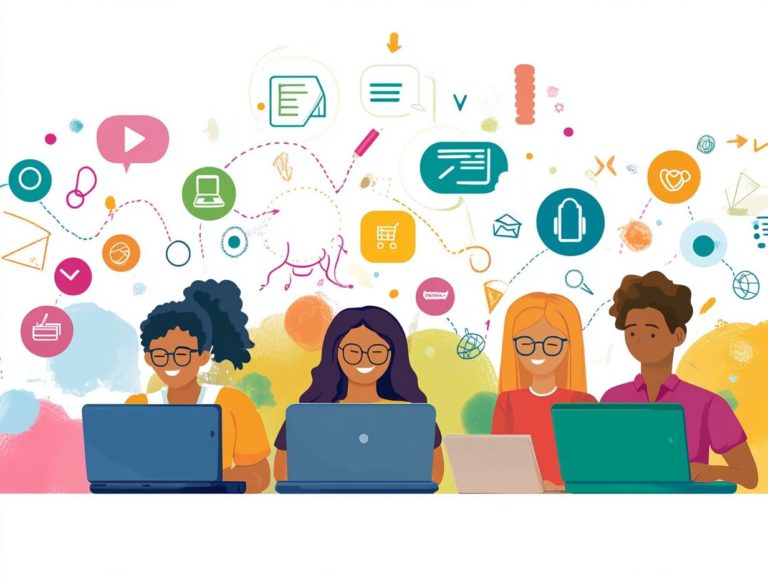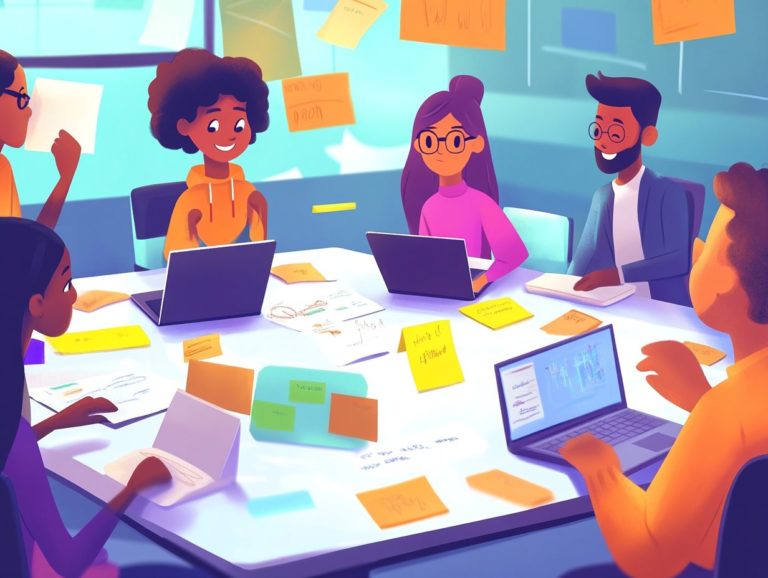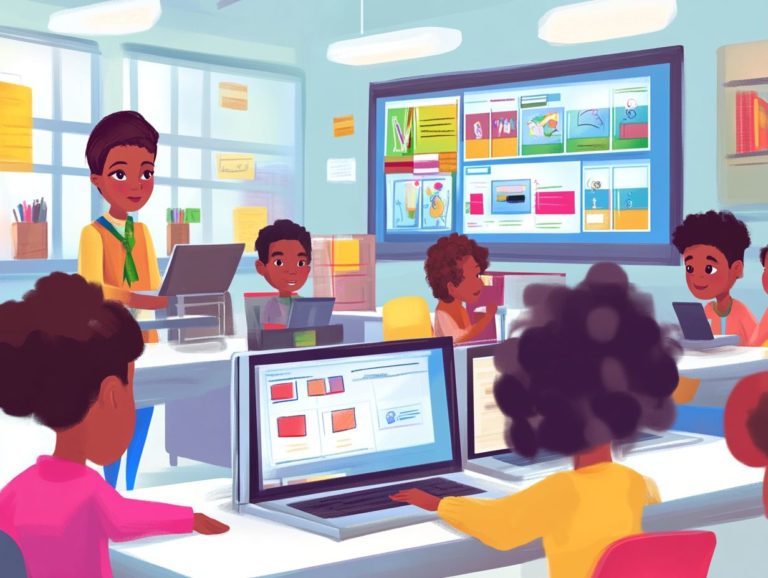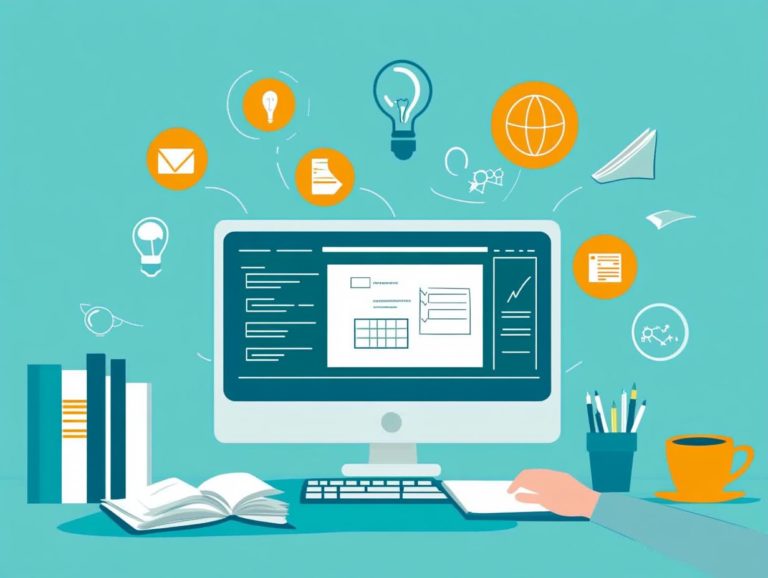5 Benefits of Interactive E-Learning
In today’s fast-paced digital landscape, you’ll find that traditional learning methods often struggle to captivate and retain learners effectively.
Interactive e-learning presents a dynamic solution that redefines the educational experience, actively engaging you in your own learning journey.
This article delves into five key benefits of interactive e-learning, such as enhancing engagement, offering immediate feedback, enabling personalization, and accommodating diverse learning styles.
You ll also explore its broader applications across various industries and the future trends that are shaping its evolution.
See how interactive e-learning can revolutionize your learning journey!
Contents
- Key Takeaways:
- 1. Engages Learners in a More Active Way
- 2. Provides Immediate Feedback
- 3. Allows for Personalized Learning
- 4. Increases Retention and Understanding
- 5. Offers Flexibility for Different Learning Styles
- What Is Interactive E-Learning and How Does It Work?
- Your Questions Answered!
- What is interactive e-learning and how does it differ from traditional learning?
- What are the benefits of interactive e-learning?
- How does interactive e-learning increase engagement?
- Why is immediate feedback important in e-learning?
- What impact does interactive e-learning have on retention rates?
- How does interactive e-learning provide flexible learning options?
Key Takeaways:

- Engages learners in active and immersive learning experiences, enhancing their understanding and retention of information.
- Provides immediate feedback to learners, allowing them to track their progress and address any areas of difficulty in real-time.
- Allows for personalized learning, catering to the individual needs and pace of each learner.
1. Engages Learners in a More Active Way
Engaging learners actively is at the heart of modern online education. You ll find that leveraging interactive learning methods enriches your educational experience and helps build a strong learning community, much like what s offered on platforms such as HBS Online.
Digital platforms use innovative tools and real-world examples to keep you engaged, encouraging collaborative learning and enhancing your educational outcomes by allowing you to interact with course content in a dynamic manner.
The integration of discussion forums and gamification using game-like elements to make learning more engaging does more than just motivate you; it creates an environment where you can express ideas and exchange feedback, which is invaluable for your growth.
By participating in discussions, you can deepen your understanding while applying theoretical concepts to real-world situations, effectively bridging the gap between academia and the professional world.
Feedback mechanisms offer you immediate insights, helping you refine your skills and knowledge. This ongoing interaction fosters a supportive community where you can thrive, share your diverse experiences, and develop the critical thinking capabilities essential for tackling real-world challenges.
2. Provides Immediate Feedback
Immediate feedback shapes your learning experience. It offers you the opportunity to quickly assess your understanding and make necessary adjustments to enhance your learning outcomes.
Using a variety of methods like quizzes, polls, and interactive tools, educators can create an environment where you feel supported and motivated. Quizzes allow you to gauge your knowledge in real-time, while interactive tools such as discussion boards and gamified assessments foster a sense of community.
This immediate feedback highlights your strengths and weaknesses and encourages peer interaction, boosting your engagement and commitment to the learning journey. With timely suggestions and resources at your fingertips, you are better equipped to participate actively and collaboratively, promoting a more enriching educational experience.
3. Allows for Personalized Learning
Personalized learning stands out as a remarkable advantage of online education, enabling you to tailor your educational journey to fit your unique needs and preferences. This customization heightens your engagement and boosts your satisfaction within the learning community.
This flexibility caters to various learning styles and gives you the power to progress at your own pace, making education more inclusive. For instance, platforms like HBS Online offer customized learning paths, allowing you to select specific modules that align with your interests and career aspirations.
This versatility lets you delve deeply into subjects you’re passionate about while providing a diverse array of courses to equip you with relevant skills for the job market.
Moreover, through interactive group projects and peer feedback, personalized learning encourages collaboration, further enhancing your educational experience.
Ready to take the next step in your learning journey? Explore courses that fit your interests today!
4. Increases Retention and Understanding

Increased retention and understanding are the cornerstones of well-designed online courses that weave in interactive learning techniques and real-world examples, creating richer cognitive connections so you will gain.
When educational institutions prioritize engagement strategies like turning learning into a game-like experience and group learning settings, they don t just capture your attention; they elevate your entire learning experience.
For example, a study conducted by the University of Colorado found that students who engaged in gamified courses saw a remarkable 20% boost in retention rates compared to traditional methods.
Group learning settings enhance not only academic performance but also critical thinking skills. Active participation deepens your understanding and lays a solid foundation for lasting educational success.
5. Offers Flexibility for Different Learning Styles
Flexibility in online education is paramount for accommodating the diverse spectrum of learning styles. This adaptability allows you to engage with course content in ways that align with your individual preferences and needs, effectively navigating various community challenges.
Different digital platforms provide a wealth of tools designed specifically for these varied styles. For instance, if you’re a visual learner, you’ll thrive with infographics and videos, while auditory learners find their groove through podcasts and lively discussion forums.
Kinesthetic learners, on the other hand, are particularly drawn to interactive simulations and hands-on projects that keep them engaged.
Remote learning also enhances these options, so you can join in fully, no matter your geographical location or logistical constraints.
This level of adaptability creates a more inclusive environment, enabling you to flourish at your own pace and encouraging your personal growth throughout the learning journey.
What Is Interactive E-Learning and How Does It Work?
Interactive e-learning is more than just a trend; it s a dynamic approach to online education that harnesses a variety of digital platforms to create engaging learning experiences. This method gives you the power to implement innovative engagement strategies, effectively fostering community support while enhancing educational outcomes.
Embrace this approach now to make learning accessible and encourage collaboration among students from diverse backgrounds, enriching the overall educational experience. Utilizing tools such as discussion forums, gamified assessments, and multimedia resources like videos, podcasts, and interactive exercises, platforms like HBS Online demonstrate how interactive e-learning can stimulate critical thinking and facilitate peer-to-peer learning.
These environments offer you a unique opportunity to connect with a global network of lifelong learners, cultivating a sense of belonging and promoting continuous personal and professional growth in an ever-evolving world.
What Are the Different Types of Interactive E-Learning?
Interactive e-learning offers a rich tapestry of experiences, from gamified courses to simulations and collaborative projects, each meticulously crafted to enhance your learning journey. Additionally, exploring ways to encourage knowledge sharing can further cater to your unique educational needs and preferences.
Gamified courses infuse game-like elements think points, badges, and leaderboards into the learning process, sparking your motivation and transforming education into an engaging competition.
Simulations, on the other hand, immerse you in realistic environments where you can safely practice skills, deepening your understanding through hands-on experience.
Collaborative projects invite you to work alongside others, honing your teamwork and communication skills in the process.
Each type plays a vital role in elevating user engagement. While gamified courses draw in those who thrive on competition, simulations and collaborative efforts provide the flexibility you need to adapt your pace and enhance your comprehension.
How Can Interactive E-Learning Benefit Businesses?

Interactive e-learning offers many benefits for your business. It provides cost-effective educational solutions that boost professional development and improve employee engagement, ultimately paving the way for career advancement.
By incorporating interactive elements like quizzes, simulations, and peer discussions, you can create a more immersive learning environment. This approach promotes collaboration and knowledge retention while giving employees the power to apply their skills in real-world scenarios.
You ll be able to track progress and analyze performance metrics, yielding invaluable insights into your training’s effectiveness. Many businesses see a higher return on investment through improved productivity, reduced turnover rates, and a more skilled workforce.
These transformative benefits play a crucial role in boosting your organization’s overall success and competitiveness in the marketplace.
What Are the Potential Drawbacks of Interactive E-Learning?
While interactive e-learning offers many benefits, it’s essential to recognize potential drawbacks that could impact your experience, such as technical issues and community challenges that may affect engagement. For a deeper understanding, consider exploring 5 tools for creating interactive e-learning.
You might face several obstacles, such as software glitches, unreliable internet connections, or communication tools that leave you feeling isolated. Without a supportive community, your motivation might decrease, especially if you struggle to connect with peers for collaboration or idea-sharing. A lack of timely feedback can cause frustration, as you often crave constructive input to deepen your understanding.
To tackle these challenges, act now to secure reliable technology and foster a supportive community! Encourage vibrant virtual communities through discussion forums and peer interactions. Implement robust feedback systems that enable real-time responses to significantly enhance your learning experience.
How Can Interactive E-Learning Be Used in Different Industries?
Interactive e-learning can be a game-changer for you, effectively utilized across various industries to provide tailored online courses that directly address professional development needs. Implementing 5 tips for engaging employees in e-learning can leverage real-world examples to enhance learning outcomes.
Take the healthcare sector, for instance. Interactive e-learning platforms allow you to engage in simulated patient scenarios, honing skills in a risk-free environment. One standout example is a nursing program that employed a virtual simulation tool, enabling students to practice critical decision-making in emergency situations, ultimately leading to improved patient care.
In the tech industry, software development training incorporates gamified learning modules that encourage hands-on practice through coding challenges. These engaging approaches keep you motivated and equip you to tackle real-world challenges effectively, fostering a more competent workforce ready to excel.
What Are the Future Trends of Interactive E-Learning?
The future of interactive e-learning is set to soar, fueled by cutting-edge digital education technologies and innovative practices designed to enhance engagement and improve learner outcomes.
As you step into this new era, expect an educational experience that feels tailor-made just for you. This is thanks to the growing embrace of AI-driven personalization, which means using artificial intelligence to customize learning experiences based on individual needs. Your learning journey will adapt to your unique style and pace, providing a personalized touch that makes all the difference.
With mobile access at your fingertips, you can interact with content whenever and wherever it suits you. This makes learning incredibly flexible and exciting!
The incorporation of augmented and virtual reality adds another layer of excitement, creating immersive environments where exploration and collaboration thrive. These practical experiences often lack in traditional classrooms.
These emerging trends enhance education. They equip you to excel in a rapidly changing world, fundamentally shaping the future of education in ways that will undoubtedly benefit you.
Your Questions Answered!

What is interactive e-learning and how does it differ from traditional learning?
Interactive e-learning is a form of online education that uses interactive elements such as videos, quizzes, games, and simulations to engage and involve learners. It differs from traditional learning by allowing for more personalized and active learning experiences.
What are the benefits of interactive e-learning?
There are numerous benefits to interactive e-learning, including increased engagement, immediate feedback, higher retention rates, flexible learning options, and essential features of effective e-learning tools that enhance cost-effectiveness.
How does interactive e-learning increase engagement?
Interactive e-learning often incorporates multimedia and gamification elements, which can make the learning experience more fun and engaging. To further improve this experience, consider implementing 5 ways to enhance accessibility in e-learning, encouraging learners to take a more hands-on approach to learning.
Why is immediate feedback important in e-learning?
In traditional learning, feedback can often be delayed or limited. With interactive e-learning, learners receive instant feedback on their progress and performance, allowing them to identify areas for improvement and make necessary adjustments in real-time.
What impact does interactive e-learning have on retention rates?
Studies have shown that interactive e-learning can lead to higher retention rates compared to traditional methods. This is due to the engaging and interactive nature of the activities, which can help learners retain information more effectively. Incorporating creative ways to use e-learning in training can further enhance this experience.
How does interactive e-learning provide flexible learning options?
Interactive e-learning allows learners to access materials and complete activities at their own pace and on their own schedule. This flexibility is especially beneficial for those with busy schedules or different learning styles, and it can be enhanced by looking at successful e-learning implementation examples.
Explore interactive e-learning today and transform your learning journey!






